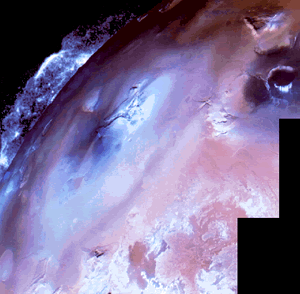 A volcanic eruption on the surface of Io
A volcanic eruption on the surface of Io
taken by the Voyager spacecraft. Credit: NASA/VoyagerPlanets hog a lot of press, inside and outside the Solar System, but there's a lot to be said for those "second class" worlds that are the satellites of the planets--some of which would be true planets (fascinating ones, too) if it weren't for the fact that they orbit another planet instead of the Sun.
I'd like to point out a few things about these little worlds of which you may not be aware.
I have to start with Earth's own satellite--the Moon (or Luna, by the Latin name). Whether or not large moons are common around Earth-sized planets, they really are not common in our Solar System. Earth has one very sizable moon, a quarter the diameter of Earth itself, whereas none of the other terrestrial planets really do. Mars' two moons are pint-sized--roughly comparable to Mount Diablo in size. And that's it. (I can avoid talking about Pluto's moon, Charon, since Pluto isn't an official planet... please don't throw the rotten fruit!)
Mars' satellites--14-mile Phobos and 6-mile Deimos--are possibly asteroids captured from the Asteroid Belt, which neighbors Mars. Many of Jupiter's current count of 63 moons are also probably absconded asteroids.
It's Jupiter where the satellite worlds truly begin, Luna notwithstanding. As I mentioned, some moons would be planets if only they orbited the Sun directly. Jupiter's largest moon (the Solar System's largest, for that matter) is Ganymede, with a diameter that exceeds that of Mercury.
